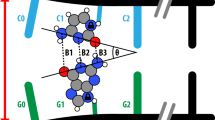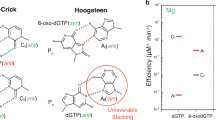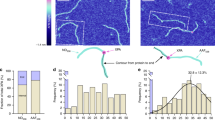Abstract
THE possibility has been considered for almost forty years that the DNA double helix, which contains a π-stacked array of heterocyclic base pairs, could be a suitable medium for the migration of charge over long molecular distances1–11. This notion of high charge mobility is a critical consideration with respect to DNA damage. We have previously found7–10 that the DNA double helix can serve as a molecular bridge for photo-induced electron transfer between metallointercalators, with fast rates (≥1010 S−1)10 and with quenching over a long distance (>40Å)8. Here we use a metallointercalator to introduce a photoexcited hole into the DNA π-stack at a specific site in order to evaluate oxidative damage to DNA from a distance. Oligomeric DNA duplexes were prepared with a rhodium inter-calator covalently attached to one end and separated spatially from 5′-GG-3′ doublet sites of oxidation. Rhodium-induced photo-oxidation occurs specifically at the 5′-G in the 5′-GG-3′ doublets and is observed up to 37 Å away from the site of rhodium intercalation. We find that the yield of oxidative damage depends sensitively upon oxidation potential and π-stacking, but not on distance. These results demonstrate directly that oxidative damage to DNA may be promoted from a remote site as a result of hole migration through the DNA π-stack.
This is a preview of subscription content, access via your institution
Access options
Subscribe to this journal
Receive 51 print issues and online access
$199.00 per year
only $3.90 per issue
Buy this article
- Purchase on Springer Link
- Instant access to full article PDF
Prices may be subject to local taxes which are calculated during checkout
Similar content being viewed by others
References
Szent-Györgyi, A., Isenberg, I. & Baird, S. L. Jr. Proc. natn. Acad. Sci. U.S.A. 46, 1444–1449 (1960).
Cullis, P. M., McClymont, J. D. & Symons, M. C. R. J. chem. Soc. Farad. Trans. 86, 591–592 (1990).
Snart, R. S. Biopolymers 6, 293–297 (1968).
Stemp, E. D. A. & Barton, J. K. Metal Ions Biol. Sys. 33, 325–365 (1996).
Fromherz, P. & Rieger, B. J. Am. chem. Soc. 108, 5361–5362 (1986).
Brun, A. M. & Harriman, A. J. Am. chem. Soc. 114, 3656–3660 (1992).
Purugganan, M. D., Kumar, C. V., Turro, N. J. & Barton, J. K. Science 241, 1645–1649 (1988).
Murphy, C. J. et al. Science 262, 1025–1029 (1993).
Murphy, C. J. et al. Proc. natn. Acad. Sci. U.S.A. 91, 5315–5319 (1994).
Arkin, M. R. et al. Science (in the press).
Meade, T. J. & Kayyem, J. F. Angew. Chem. Int. Ed. Engl. 34, 352–354 (1995).
Saito, I. et al. J. Am. chem. Soc. 117, 6406–6407 (1995).
Kittler, L. et al. J. Electroanalyt. Chem. 116, 503–511 (1980).
Retél, J. et al. Mutation Res. 299, 165–182 (1993).
Kasai, H., Yamaizumi, Z., Berger, M. & Cadet, J. J. Am. chem. Soc. 114, 9692–9694 (1992).
Ito, K., Inoue, S., Yamamoto, K. & Kawanishi, S. J. biol. Chem. 268, 13221–13227 (1993).
Breslin, D. T. & Schuster, G. B. J. Am. chem. Soc. 118, 2311–2319 (1996).
Chung, M.-H., Kiyosawa, H., Nishimura, S. & Kasai, H. Biochem. biophys. Res. Commun. 188, 1–7 (1992).
Johann, T. W. & Barton, J. K. Phil. Trans. R. Soc. Lond. A 354, 299–324 (1996).
David, S. S. & Barton, J. K. J. Am. chem. Soc. 115, 2984–2985 (1993).
Sitlani, A., Long, E. C., Pyle, A. M. & Barton, J. K. J. Am. chem. Soc. 114, 2303–2312 (1992).
Turro, C., Evenzahav, A., Bossman, S. H., Barton, J. K. & Turro, N. J. Inorg. Chim. Acta 243, 101–108 (1996).
Mei, H.-Y. & Barton, J. K. Proc. natn. Acad. Sci. U.S.A. 85, 1339–1343 (1988).
Hertzberg, R. P. & Dervan, P. B. Biochemistry 23, 3934–3945 (1984).
Barciszewski, J., Barciszewski, M. Z., Rattan, S. I. S. & Clark, B. F. C. Polish J. Chem. 69, 841–851 (1995).
Barton, J. K. Science 233, 727–734 (1986).
Melvin, T., Plumb, M. A., Botchway, S. W., O'Neill, P. & Parker, A. W. Photochem. Photobiol. 61, 584–591 (1995).
Shibutani, S., Takeshita, M. & Grollman, A. P. Nature 349, 431–434 (1991).
von Zglinicki, T., Saretzki, G., Döcke, W. & Lotze, C. Expl Cell Res. 220, 186–193 (1995).
Wachter, L., Jablonski, J. A. & Ramachandran, K. L. Nucleic. Acids Res. 14, 7985–7994 (1986).
Author information
Authors and Affiliations
Rights and permissions
About this article
Cite this article
Hall, D., Holmlin, R. & Barton, J. Oxidative DNA damage through long-range electron transfer. Nature 382, 731–735 (1996). https://doi.org/10.1038/382731a0
Received:
Accepted:
Issue Date:
DOI: https://doi.org/10.1038/382731a0
This article is cited by
-
Widespread 8-oxoguanine modifications of miRNA seeds differentially regulate redox-dependent cancer development
Nature Cell Biology (2023)
-
o8G modifications rewire tumoral microRNAs
Nature Cell Biology (2023)
-
8-Oxoguanine: from oxidative damage to epigenetic and epitranscriptional modification
Experimental & Molecular Medicine (2022)
-
Switch-on effect on conformation-specific arylamine–DNA adduct by cyclometalated Ir(III) complexes
JBIC Journal of Biological Inorganic Chemistry (2020)
-
The optical properties of adenine cation in different oligonucleotides: a PCM/TD-DFT study
Theoretical Chemistry Accounts (2018)
Comments
By submitting a comment you agree to abide by our Terms and Community Guidelines. If you find something abusive or that does not comply with our terms or guidelines please flag it as inappropriate.



